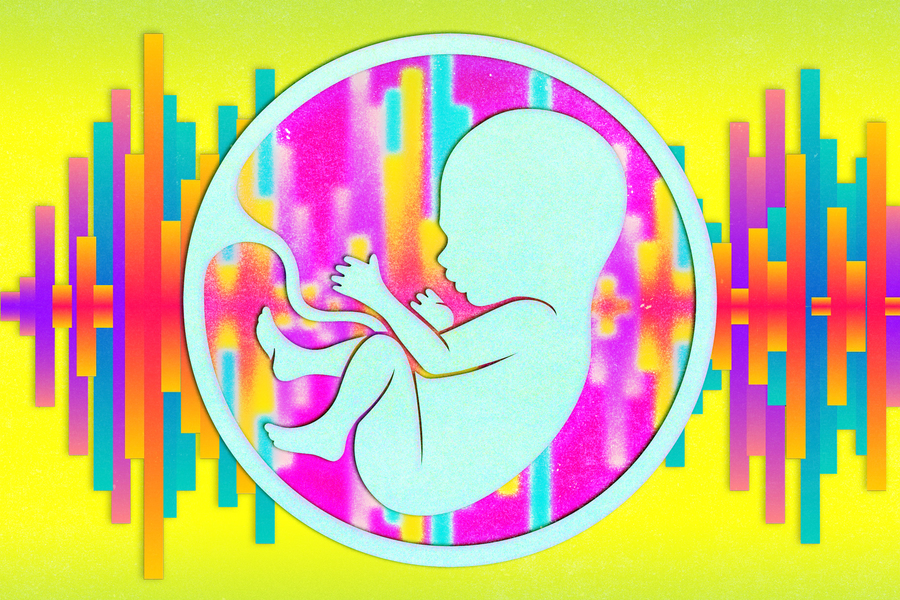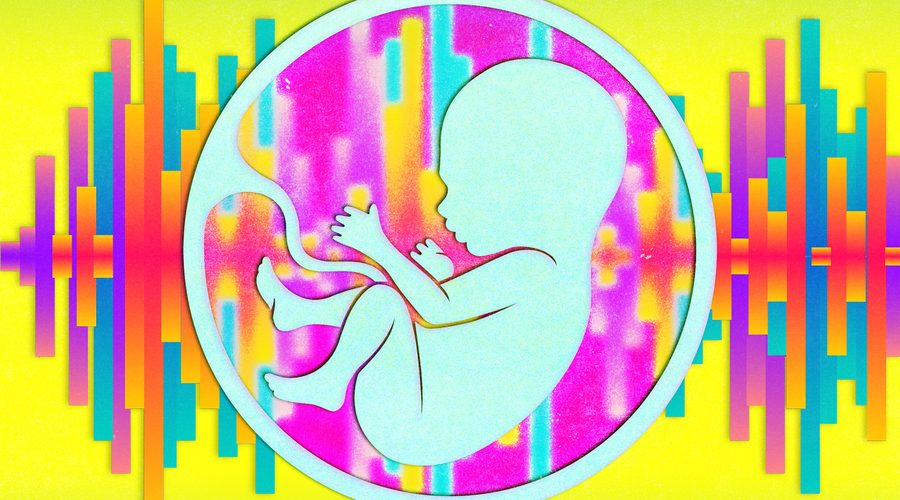Source: [Anne Trafton | MIT News Office, May 25, 2022]
Modeling study suggests that the muffled environment in utero primes the brain’s ability to interpret some types of sound.

Image: Jose-Luis Olivares, MIT, with images from iStockphoto
Inside the womb, fetuses can begin to hear some sounds around 20 weeks of gestation. However, the input they are exposed to is limited to low-frequency sounds because of the muffling effect of the amniotic fluid and surrounding tissues.
A new MIT-led study suggests that this degraded sensory input is beneficial, and perhaps necessary, for auditory development. Using simple computer models of the human auditory processing, the researchers showed that initially limiting input to low-frequency sounds as the models learned to perform certain tasks actually improved their performance.
Along with an earlier study from the same team, which showed that early exposure to blurry faces improves computer models’ subsequent generalization ability to recognize faces, the findings suggest that receiving low-quality sensory input may be key to some aspects of brain development.
“Instead of thinking of the poor quality of the input as a limitation that biology is imposing on us, this work takes the standpoint that perhaps nature is being clever and giving us the right kind of impetus to develop the mechanisms that later prove to be very beneficial when we are asked to deal with challenging recognition tasks,” says Pawan Sinha, a professor of vision and computational neuroscience in MIT’s Department of Brain and Cognitive Sciences, who led the research team.
In the new study, the researchers showed that exposing a computational model of the human auditory system to a full range of frequencies from the beginning led to worse generalization performance on tasks that require absorbing information over longer periods of time — for example, identifying emotions from a voice clip. From the applied perspective, the findings suggest that babies born prematurely may benefit from being exposed to lower-frequency sounds rather than the full spectrum of frequencies that they now hear in neonatal intensive care units, the researchers say.
Marin Vogelsang and Lukas Vogelsang, currently both students at EPFL Lausanne, are the lead authors of the study, which appears in the journal Developmental Science. Sidney Diamond, a retired neurologist and now an MIT research affiliate, is also an author of the paper.
Low-quality input
Several years ago, Sinha and his colleagues became interested in studying how low-quality sensory input affects the brain’s subsequent development. This question arose in part after the researchers had the opportunity to meet and study a young boy who had been born with cataracts that were not removed until he was four years old.
This boy, who was born in China, was later adopted by an American family and referred to Sinha’s lab at the age of 10. Studies revealed that his vision was nearly normal, with one notable exception: He performed very poorly in recognizing faces. Other studies of children born blind have also revealed deficits in face recognition after their sight was restored.
The researchers hypothesized that this impairment might be a result of missing out on some of the low-quality visual input that babies and young children normally receive. When babies are born, their visual acuity is very poor — around 20/800, 1/40 the strength of normal 20/20 vision. This is in part because of the lower packing density of photoreceptors in the newborn retina. As the baby grows, the receptors become more densely packed and visual acuity improves.
“The theory we proposed was that this initial period of blurry or degraded vision was very important. Because everything is so blurry, the brain needs to integrate over larger areas of the visual field,” Sinha says.
To explore this theory, the researchers used a type of computational model of vision known as a convolutional neural network. They trained the model to recognize faces, giving it either blurry input followed later by clear input, or clear input from the beginning. They found that the models that received fuzzy input early on showed superior generalization performance on facial recognition tasks. Additionally, the neural networks’ receptive fields — the size of the visual area that they cover — were larger than the receptive fields in models trained on the clear input from the beginning.

